LHC experiments restart
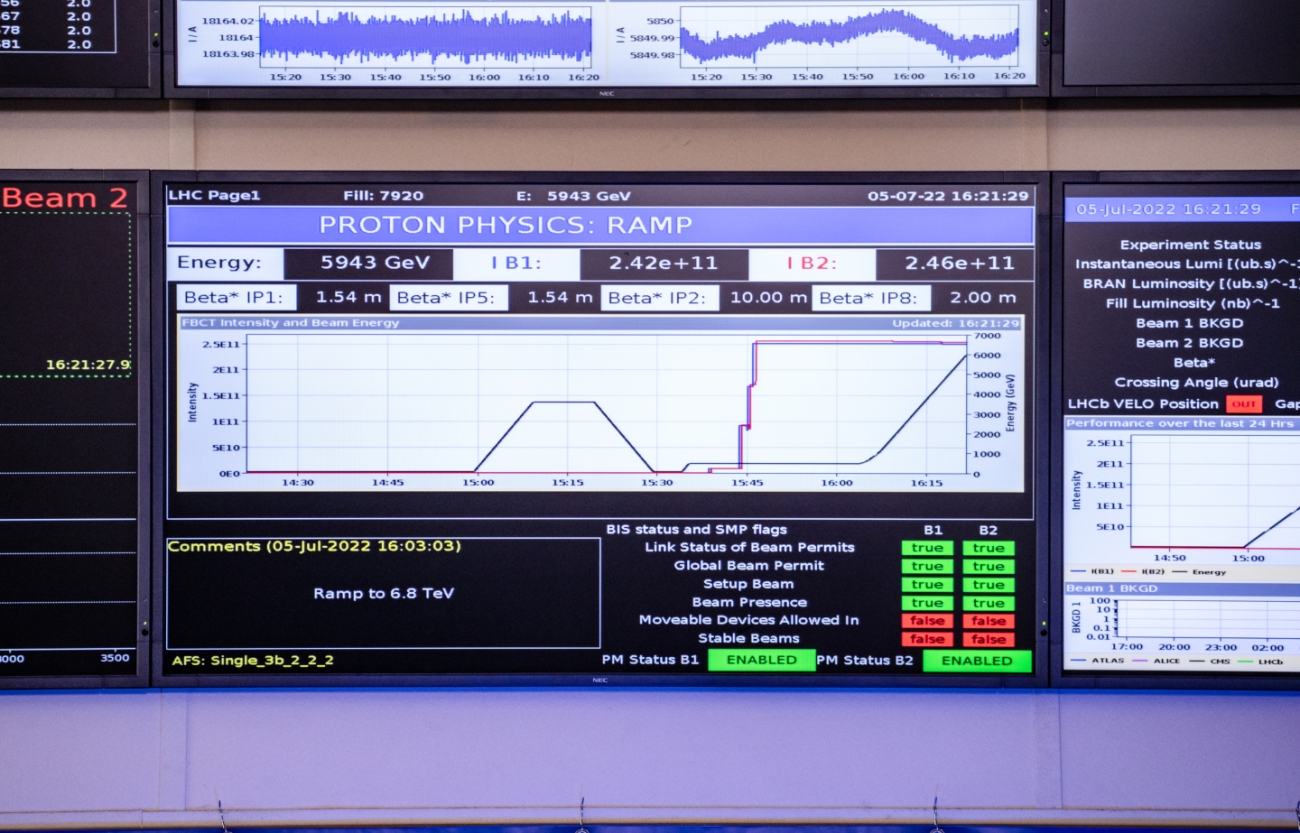
The LHC restarted this summer, after a period of upgrades (LS2) and is gearing up to probe new realms of physics during a third run, which will be its most powerful yet. Run 3 of the LHC will feature higher-energy particle beams and higher collision rates, allowing physicists to collect more data than in the previous two runs combined.
On the 5th of July 2022, declaration of “stable beams” marked the end of the LHC’s re-commissioning period, which began in April 2022. Within a month from today, the LHC will have reached its full Run-3 operating intensity. The anticipated Run 3 data will almost triple the total data set; a major step forward, in particular for studies probing the high energy frontier, such as new particle searches and, probably more importantly, measurements of Higgs boson properties that are basically limited by the number of available data events.
LHC will run around the clock for nearly 4 years, with only some technical stops during the winter months, delivering an unprecedented wealth of proton and heavy-ion collisions. The data that have been collected until today is only one 10th of what is planned over the lifetime of the LHC’s lifetime. This offers a great potential for experimental exploration, exploring the parameter space of our current models and testing new ideas.
The day was also celebrated with a live event streamed on all the major social media platforms by CERN, in collaboration with the four LHC experiments.
ATLAS Experiment records “first physics” at new high-energy frontier
“We have proton collisions in the ATLAS experiment.” At 16.47 CEST, the Large Hadron Collider (LHC) officially kicked off its third period of operation (Run 3). ATLAS has now switched on all systems to begin recording data to be used for physics analysis. “The ATLAS experiment stands ready to record this new harvest of data,” says Andreas Hoecker, ATLAS Spokesperson. “The new run promises to more than triple the currently accumulated dataset at a new energy frontier. We have prepared a broad scientific programme, taking advantage of new upgrades to our experiment."
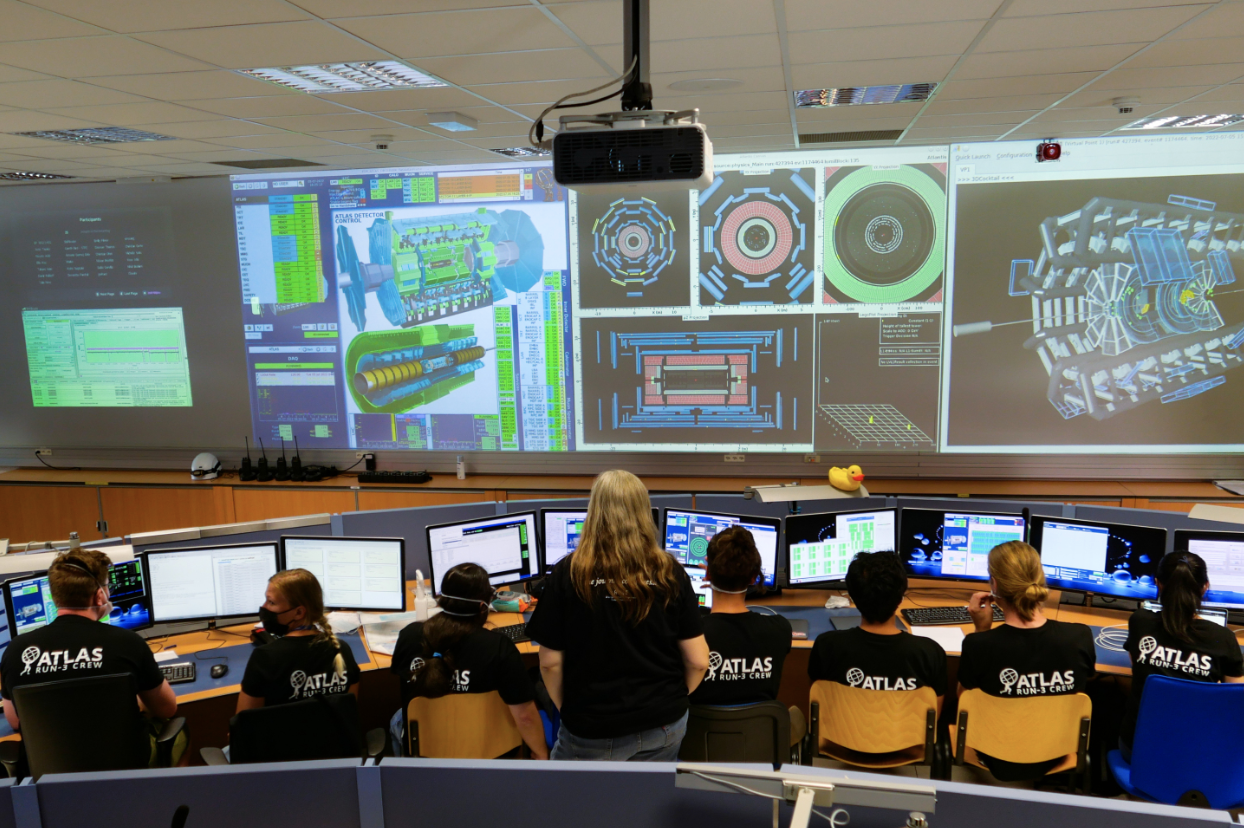
The return of LHC beams comes after more than three years of upgrade and maintenance work, with new detector systems and electronic infrastructure installed in the ATLAS cavern. “We are excited to see the ATLAS control room busy again as we prepare for Run-3 data taking,” says Jörg Stelzer, ATLAS Run Coordinator. “We have spent the past several months re-commissioning the experiment, and re-establishing the expertise and procedures that led to the outstanding data-taking efficiency of Run 2. This will be our model for Run 3.”
“Run 3 will see our sensitivity to new physics processes increase, as we explore new types of collision events that were previously out of reach,” says Pamela Ferrari, ATLAS Deputy Physics Coordinator. “During the shutdown, we paid particular attention to improving our online event filtering system (or ‘trigger’). By refining our selection upstream with new detector systems, we should be able to identify some of the most difficult-to-spot signatures which could be left by new particles”.
Among the event signatures that would benefit from the new triggers is dark matter production. “The search for dark matter is a very important part of our physics research programme,” says Andreas. “We know from numerous observations of gravitational effects that dark matter exists in the universe. If it is made of particles, as most physicists expect, these may interact with protons or the Higgs boson and be produced in LHC collisions.” Dark matter is invisible and can only be spotted when produced with other, visible particles. The dark matter then appears as localised missing energy in a collision event, which physicists can measure.
Of course, a centrepiece of the ATLAS physics programme remains the Higgs boson. While it was discovered in Run 1 essentially through its interactions with force-carrier bosons, the larger and higher-energy Run-2 data sample allowed ATLAS to measure Higgs-boson interactions to matter particles (fermions) of the heaviest, third generation, and to observe all of its major production modes. In Run 3, these measurements will be further improved and the Higgs boson interactions with second-generation particles, such as muons, and its interaction with itself will become a focus.
"The Higgs sector is a rich environment for study, as precise measurements of its properties can yield spectacular results,” adds Pamela. “Constraining and eventually measuring its self-coupling will inform us about the energy potential of the Higgs field, which drives the phase transition in the early universe that transformed massless elementary particles into massive ones.”
These are but a few of the scientific highlights expected from Run 3. “As we enter this new era of exploration, it is important to champion the competence, dedication and hard work of the several hundreds of ATLAS members who implemented the upgrades and maintenance of our experiment during the long shutdown,” says Andreas. "Their work planted the seeds for the upcoming data harvest."
The many improvements to the sophisticated trigger and data acquisition system permit a much wider range of collision events to be explored, compared to Run 2, while maintaining the same particle acceptance rate. "In addition to the new hardware, ATLAS upgraded large parts of its software, simulation and computing environment to boost performance, save resources and enable it for use with heterogeneous computing systems," concludes Andreas.
A busy summer for the CMS Experiment
Yesterday, 5th of July 2022, the Large Hadron Collider (LHC) at CERN delivered proton-proton collisions at the energy of 13.6 trillion electron volts (TeV) for the first time, setting a new world record. The CMS experiment, on the front line, recorded these first collisions with all its systems turned on and highly operative.
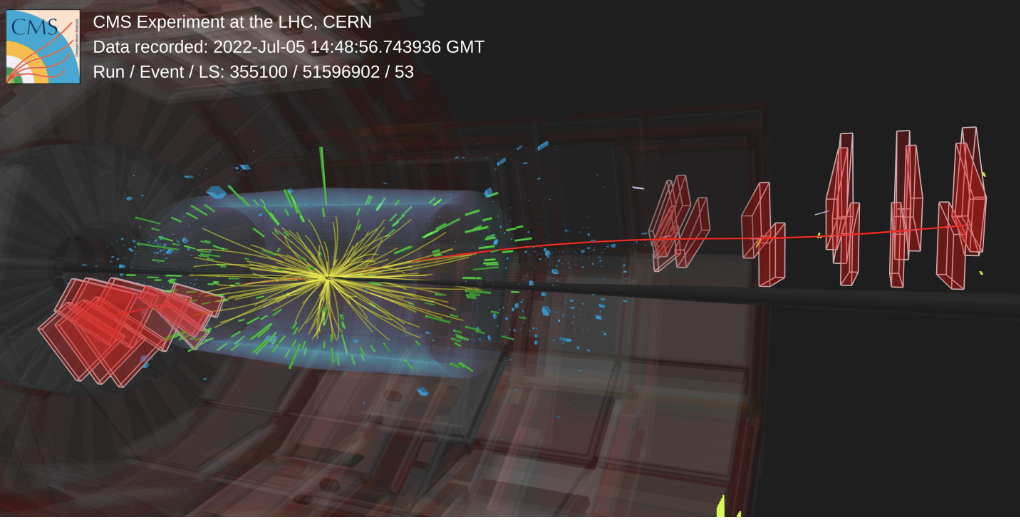
CMS recorded first collision events at 13.6 trillion electron volts (TeV)
The start of the new run filled the CMS control room with a different level of joy as the excellent performance of the detector validated the hard work performed during Long Shutdown 2. Indeed, for more than the past three years, the CMS collaboration worked extensively on maintenance and major detector upgrades.
“The smooth restart of operation after Long Shutdown 2 is the result of a collaboration between many different teams, at CERN but also everywhere in the world. With these first collisions, the CMS detector will move from commissioning to efficient operation in order to record collisions and feed the vast Run 3 science program.” said Gaelle Boudoul, head of the CMS Run coordination team.
For scientists staring at the monitors in the CMS control room, the first collision is no less exciting than the first firework on New Year’s Eve, full of all those expectations that only a new beginning can inspire. Indeed, CMS is expecting to receive more collisions during this Run 3 than the previous two physics runs combined. Moreover, the performance of the CMS trigger system in selecting the data coming from the collisions is improved by about 20-30%, opening completely new scenarios of physics searches.
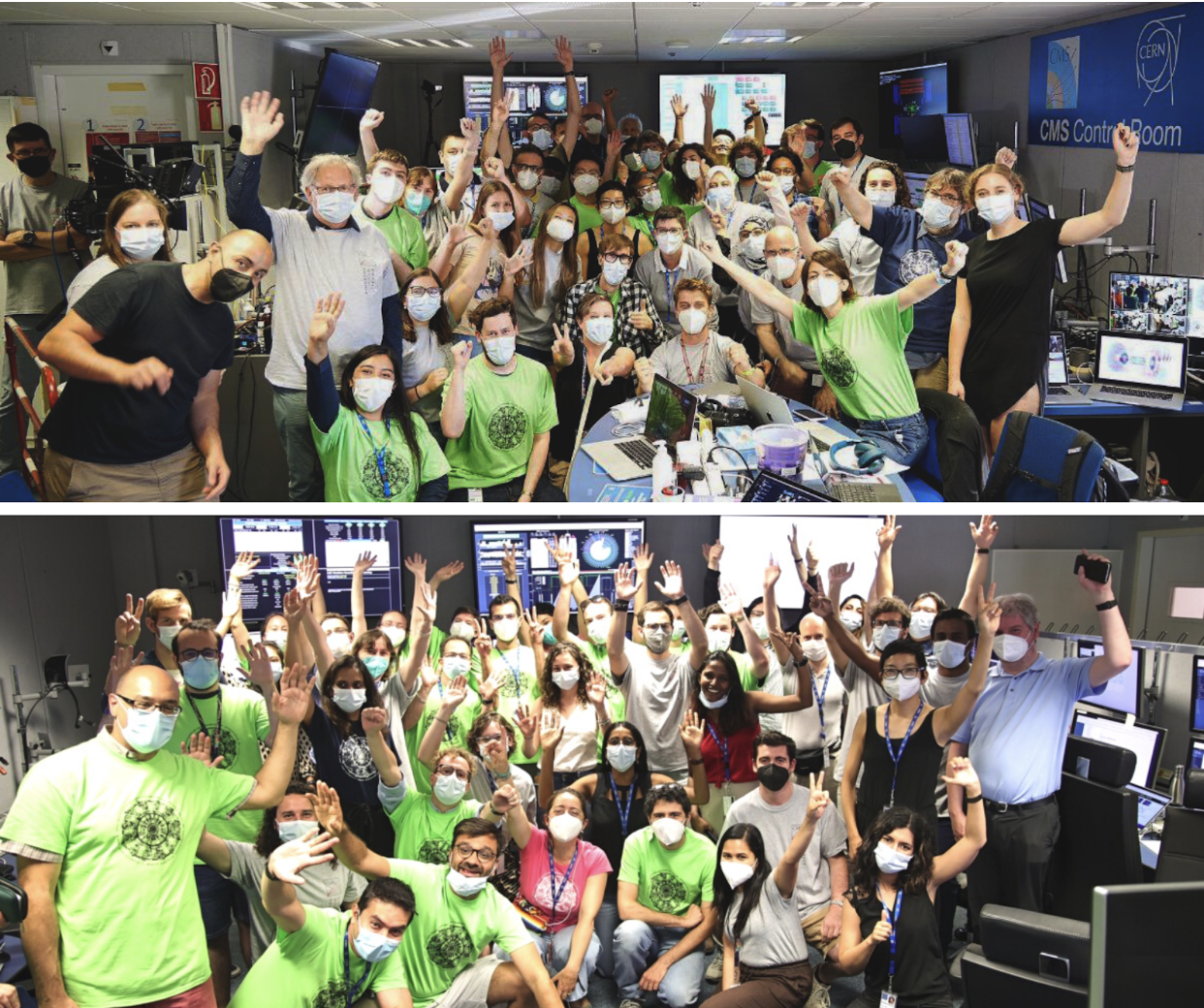
The CMS control room is full of joy.
Over the following weeks, the accelerator gradually increased the number of protons colliding in the machine, thereby inducing an increase in the collision rate. This is a crucial step for the CMS detector. The muon chambers were able to collect enough muon particles to calibrate and optimize their response. The calorimeters and the tracker are also aligned, and the luminometers are at this stage fine-tuning their accuracy. As of today, the LHC is almost at the maximum intensity that it will be able to deliver during Run 3. This allowed CMS to set up the entire trigger system, which is extremely valuable to select the physics events covering the vast research program planned to take place during Run 3 by the CMS collaboration.
With conditions being rather stable, there are no major plans for a change or a new installation within the CMS apparatus during the next LHC technical stop scheduled for a few days in September. Instead, later in the year, we will focus on preparing the detector and the associated software in more depth for the first Run 3 heavy ion campaign, which will be held in November. This dedicated campaign will close this very special year, where the LHC successfully restarted and where already many collision events are recorded for physics analyses. The long research journey of Run 3 is now fully launched and the CMS experiment is on its way to explore new undiscovered territories of particle physics.
ALICE gears up for a rich physics programme
The ALICE detector has undergone a major upgrade during the LHC long shutdown 2. New inner trackers, instrumented with monolithic active pixel detectors with a spatial resolution of about 5 microns, were installed in the central-rapidity barrel and forward muon-spectrometer acceptances. The new GEM-based readout planes of the time projection chamber, the new fast trigger detector, the readout upgrade of several other detector components, and an integrated online-offline processing system, will enable recording Pb-Pb collisions at an interaction rate of up to 50 kHz. The upgraded apparatus was commissioned with cosmic-ray muons and, in October 2021 and May-June 2022, with proton-proton collisions at the LHC injection centre-of-mass energy of 900 GeV.
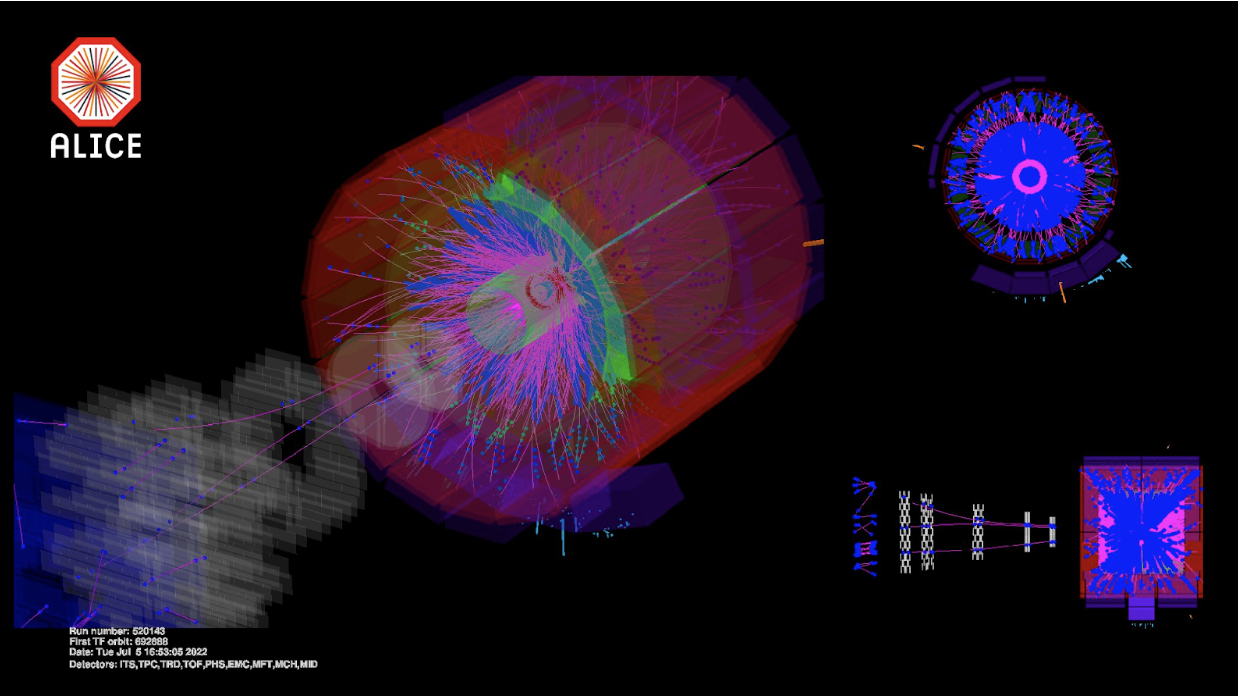
First collisions of LHC Run 3 recorded by ALICE on 5 July 2022.
A number of benchmark analyses of the new data were carried out in order to fully validate the new hardware, online and offline processing software, as well as a redesigned analysis framework that meets the larger data-throughput requirements of Run 3. The benchmark analyses included measurement of the charged-particle multiplicity distribution as a function of pseudorapidity, the momentum and angular correlations functions of charged particles and identified protons, as well as the reconstruction of strange hadron weak decays. ALICE has started Run 3 with pp data-taking at the unprecedented centre-of-mass energy of 13.6 TeV from 5 July and looks forward to the lead-lead collisions!
A comprehensive look at ALICE's physics program for coming years can be read in a recent EP article: "ALICE gears up towards a rich Run 3 QCD programme".
First collisions recorded by LHCb’s brand new detector
The Long Shutdown 2, has been an immensely busy period for the LHCb collaboration as the original experiment has been largely dismantled and an almost completely new detector has been constructed and commissioned for LHC’s Run 3.
The majority of LHCb’s sub-detectors have been replaced or upgraded during LS2 in order to cope with much more demanding data-taking conditions as described below, using the most recent technological developments to design the new detectors. The VErtex LOcator (VELO) has been replaced by a new silicon pixel detector that will come as close as 5.1 mm to the proton beams. The tracking detectors have been replaced by a new high-granularity silicon micro-strip detector, the Upstream Tracker (UT), placed upstream of the magnet, and by the three stations of the Scintillating Fibre Tracker (SciFi), which is placed downstream of the magnet, and consists of 2.5m-long scintillating plastic fibre mats read out by silicon photo-multipliers.
The RICH1 is now a brand new detector: the complete optics and mechanics have been re-designed and re-built, the mirrors have a larger curvature radius, and Hybrid Photon Detectors (HPD) have been replaced by multianode photomultipliers (pmt) in both RICH1 and RICH2 detectors. The scintillating pad detector (SPD), the preshower (PS) and the first muon chamber (M1) have been removed as they are not any more needed for the hardware-based trigger as explained below. With multiple detectors, PLUME, BCM and RMS, LHCb instantaneously measures the collision rate and reconstructs the collision region that allows the LHC to ensure a constant luminosity for the collisions in LHCb. In addition, the SMOG2 system is designed to inject noble gases to the LHCb collision area to study collisions of LHC protons with these gases in a fixed-target mode. The images were taken during construction and installation of new LHCb detector, and are seen from left to right: VELO, UT, SciFi above, and RICH2 pmt, SMOG2 and beam pipe below.
The electronics connected directly to the detector (front-end) of all sub-detectors have been modified. And last but not least, the computing power of the LHCb software event selection system (trigger) has been significantly increased, and the entire readout system together with the computer farm have been moved from underground to a complete new Data Center at the surface.

The LHCb dream team in the LHCb control room.
LHCb also recorded the first collisions at a world record energy of 13.6TeV, using its upgraded Real Time Analysis trigger system. At the LHC, bunches of protons cross every 25 ns, corresponding to a frequency of 40 MHz (with about 30 MHz of events with collisions). During Run 1 and 2 the event rate was filtered down to 1 MHz with the help of fast electronics, using comparatively simple algorithms to select the most interesting events. Those events were then processed in a dedicated computer farm, located underground close to the detector; this allowed additional, more sophisticated selection criteria to be applied using software. For Run 3 and beyond, this has changed radically: the hardware-based trigger has been removed and the whole detector is read out at the full rate of 40 MHz. This allows the whole selection to be done in software, named Real Time Analysis by LHCb, meaning that it can be much more precise and flexible. Better yet, from Run 3 the pp collision rate at LHCb is increased by a factor of 5 (for experts: the luminosity will rise to 2×1033cm-2s-1). With the higher luminosity and a greatly improved ability to pick out the most interesting events, LHCb can look forward to much larger signal yields.
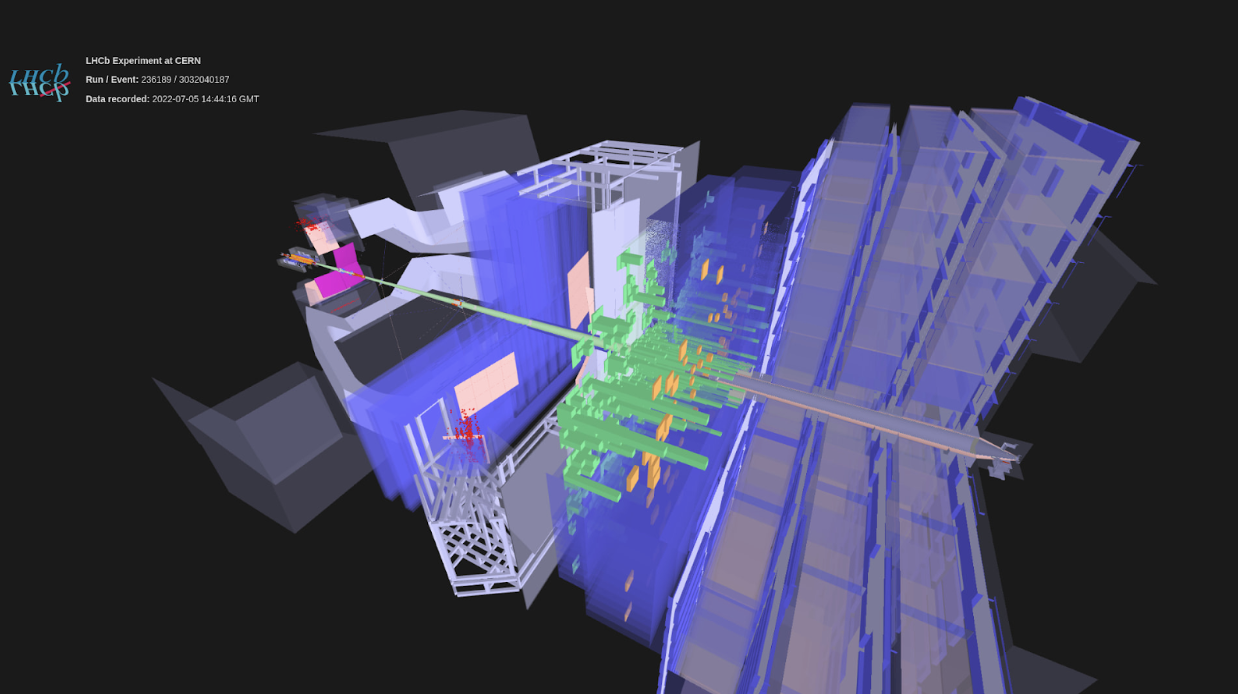
During proton-proton collisions the LHCb data taking system runs automatically under the control of just two experts, shift leader and data manager. The whole automatic system had to be set-up following installation of new detectors, new electronics and the new computer farm. This also included a set of computer programs monitoring that the whole process works correctly. During the months preceding the start of data taking, the LHCb control room was full of physicists, engineers and technicians preparing the LHCb detector for data taking during Run3.
